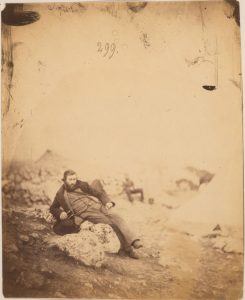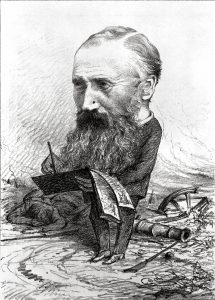William Simpson (1823-1899)
Often referred to as the ‘doyen’, the ‘prince’ and the ‘very paladin’ of pictorial correspondents, William Simpson was in fact working for Colnaghi’s, the printmakers, when he first set out to provide graphic reportage from the battlefields of the Crimea in 1854. As Simpson would later reflect, the revolutionary aspect of this artistic development was not that he provided a visual account to illustrate the news, but that he endeavoured to replicate in graphic form an actual – as opposed to imagined – view of the battle scenes he had personally witnessed. Highly conscious of the significance of his profession, he reminisced how:
‘Our Special Artist,’ in the early ages, was not supposed to be always on the spot, jotting down in his sketch-book what he saw with his own eyes. Now the artist sees what takes place, and his work is immediately given forth to the world, so that its accuracy can be tested even by the actors in the historical event. Illustrated Journalism represents this new Avatar of Art, and, although its origin may be traced further back, its real beginning and development came all within the time since Queen Victoria began her rule.
(Notes and Recollections of My Life, William Simpson, hand-written memoirs, 1889, between pp. 296-297, National Library of Scotland)

Mr Simpson the artist, Roger Fenton, Salted Paper Photograph, 1855, Library of Congress Prints and Photographs Division, Washington
Source: Library of Congress Prints and Photographs Division Washington
As lithography was still the dominant medium at this point, his Crimean drawings were lithographed and circulated as folio volumes to great popular acclaim. This success, and the tales of his courage under fire, earned him the nickname ‘Crimean Simpson’. With his customary precision, Simpson carefully recorded that this photograph of him was taken ‘at Cathcart Hill before Sebastopol’ by Roger Fenton in 1855. Simpson joined the staff of the Illustrated London News in 1866. Quickly recognised as the master of this emerging profession, his tenure at the periodical, which continued for the remainder of his life, would become the defining characteristic of his artistic career.

William Simpson, Scottish war artist and correspondent, unknown artist, Glasgow, 1874
© Victoria and Albert Museum, London
This caricatured, but respectful, image, which appeared in the Scottish press in 1874, of the eminent, self-taught watercolour artist and illustrator from Glasgow, who confidently travelled the world reporting back from places as far afield as Abyssinia, India, Egypt, China, Tibet and Afghanistan, captures the proud intensity of the man who believed passionately in the honourable duty imposed on the ‘tribe’ of Special Correspondents to which he belonged. In draft notes for his memoirs, he shared his conviction, ‘I may have to tell you a plain and simple story, but you may trust to it as a true one’ (Experiences, William Simpson, unpublished notebook, n.d.)